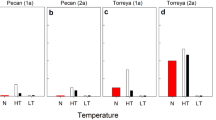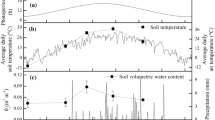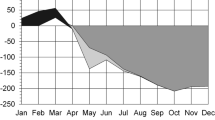Abstract
This study intended to clarify whether low irradiance, high temperature or both acted as a trigger inducing summer dormancy in Daphne pseudomezereum (Dpm), a wintergreen shrub native to Japanese mixed forests. A 2-year growth chamber experiment was conducted in Otsu, Japan where, in the first year, 3 provenances of Dpm were raised in two irradiance levels by two temperature regimes to observe their effects on leaf phenology. The results showed a clear effect of temperature, but not irradiance, on leaf phenology. In the second year, the experiment was repeated using different Dpm plants and applying only the two temperature regimes. The results confirmed those obtained in the first year, where the temperature regime that tracked normal field condition induced summer dormancy similar to field populations. In both years, when plants were kept over the summer under a cool temperature regime mimicking field conditions in April, most plants did not undergo summer dormancy (i.e., becoming “evergreen”). In contrast to phenology, leaf morphology (i.e., LMA), and photosynthetic capacity (e.g., Amax) did respond to irradiance levels consistent with shade adaptive changes, but were not affected by temperature. Simulated carbon gain using previously determined parameters for Dpm and the chamber microclimate data found that only plants in the warm treatment experienced carbon deficit in mid-summer. These findings suggest that summer temperature alone and the attendant rise in respiration can alter internal carbon balance and trigger the onset of summer dormancy in Dpm.




Similar content being viewed by others
References
Andrés F, Coupland G (2012) The genetic basis of flowering responses to seasonal cues. Nat Rev Genet 13:627–639
Augspurger CK, Salk CF, Wilson S (2017) Constraints of cold and shade on the phenology of spring ephemeral herb species. J Ecol 105:246–254
Bell KL, Bliss LC (1977) Overwinter phenology of plants in a polar semi-desert. Arctic 30:118–121
Chabot BF, Hicks DJ (1982) The ecology of leaf life span. Ann Rev Ecol Syst 13:229–259
Diez JM, Ibanez I, Miller-Rushing AJ, Mazer SJ, Crimmins TM, Crimmins MA, Bertelsen CD, Inouye DW (2012) Forecasting phenology: from species variability to community patterns. Ecol Lett 15:545–553
Fridley JD (2012) Extended leaf phenology and the autumn niche in deciduous forest invasions. Nature 485:359–362
Guy CL (1990) Cold acclimation and freezing stress tolerance: role of protein metabolism. Annu Rev Plant Physiol Plant Mol Biol 41:187–223
Jurik TW, Chabot BF (1986) Leaf dynamics and profitability in wild strawberries. Oecologia 69:296–304
Kikuzawa K, Lechowicz M (2006) Toward synthesis of relationships among leaf longevity, instantaneous photosynthetic rate, lifetime leaf carbon gain, and the gross primary production of forests. Am Nat 168:373–383
Kikuzawa K, Lechowicz M (2011) Ecology of leaf longevity. Springer, Tokyo
Korner C, Basler D (2010) Plant science. Phenology under global warming. Science 327:1461–1462
Lahti DC, Johnson NA, Ajie BC, Otto SP, Hendry AP, Blumstein DT, Coss RG, Donohue K, Foster SA (2009) Relaxed selection in the wild. Trends Ecol Evol 24:487–496
Lei TT, Koike T (1998) Some observations of phenology and ecophysiology of Daphe kamtschatica maxim ver jezoensis maxim ohwi a shade deciduous shrub in the forest of north japan. J Plant Res 111:207–212
Lei T, Yamashita N, Watanabe T, Kawahara T, Miyaura T (2020) Why does Daphne pseudomezereum drop its leaves in the summer? An adaptive alternative to surviving forest shade. Physiol Plant 168:77–87
Menzel A, Sparks TH, Estrella N, Koch E, Aasa A, Ahas R, Alm-Kübler K, Bissolli P, Braslavská OG, Briede A, Chmielewski FM, Crepinsek Z, Curnel Y, Dahl Å, Defila C, Donnelly A, Filella Y, Jatczak K, Måge F, Mestre A, Nordli Ø, Peñuelas J, Pirinen P, Remišová V, Scheifinger H, Striz M, Susnik A, Van Vliet AJH, Wielgolaski F-E, Zach S, Zust ANA (2006) European phenological response to climate change matches the warming pattern. Glob Change Biol 12:1969–1976
Munné-Bosch S, Alegre L (2004) Die and let live: leaf senescence contributes to plant survival under drought stress. Funct Plant Biol 31:203–216
Park JY, Canam T, Kang KY, Unda F, Mansfield SD (2009) Sucrose phosphate synthase expression influences poplar phenology. Tree Physiol 29:937–946
Peñuelas J, Filella I (2001) Responses to a warming world. Science 294:793–795
Peshev D, Vergauwen R, Moglia A, Hideg E, Van den Ende W (2013) Towards understanding vacuolar antioxidant mechanisms: a role for fructans? J Exp Bot 64:1025–1038
R Core Team (2013) R: a language and environment for statistical computing. R Foundation for Statistical Computing, Vienna, Austria. ISBN 3-900051-07-0. https://www.R-project.org/. Accessed 17 Dec 2019
Shalit A, Rozman A, Goldshmidt A, Alvarez JP, Bowman JL, Eshed Y, Lifschitz E (2009) The flowering hormone florigen functions as a general systemic regulator of growth and termination. Proc Natl Acad Sci USA 106:8392–8397
Smith LM, Palmer M (2013) Extended leaf phenology in deciduous forest invaders: mechanisms of impact on native communities. J Veg Sci 24:979–987
Tanino KK, Kalcsits L, Silim S, Kendall E, Gray GR (2010) Temperature-driven plasticity in growth cessation and dormancy development in deciduous woody plants: a working hypothesis suggesting how molecular and cellular function is affected by temperature during dormancy induction. Plant Mol Biol 73:49–65
The Plant List (2010) Version 1. Published on the internet. https://www.theplantlist.org/. Accessed 14 Mar 2016
Vincent G (2006) Leaf life span plasticity in tropical seedlings grown under contrasting light regimes. Ann Bot 97:245–255
Wingler A (2014) Comparison of signaling interactions determining annual and perennial plant growth in response to low temperature. Front Plant Sci 5:794
Woo HR, Kim HJ, Nam HG, Lim PO (2013) Plant leaf senescence and death-regulation by multiple layers of control and implications for aging in general. J Cell Sci 126:4823–4833
Woo HR, Masclaux-Daubresse C, Lim PO (2018) Plant senescence: how plants know when and how to die. J Exp Bot 69:715–718
Acknowledgements
I thank two anonymous reviewers for their helpful comments that have improved the reporting of this work. Funding for this research was provided in part by JSPS KAKENHI Grant No. 20380093 and by Scientific Collaboration Research Grant of Ryukoku University.
Author information
Authors and Affiliations
Corresponding author
Additional information
Communicated by Daniel L Potts.
Publisher's Note
Springer Nature remains neutral with regard to jurisdictional claims in published maps and institutional affiliations.
Electronic supplementary material
Below is the link to the electronic supplementary material.
Supplementary file2 (MOV 1111 kb)
Rights and permissions
About this article
Cite this article
Lei, T. The summer-deciduous habit of Daphne pseudomezereum is a response to warm summer as cooling converts it to an evergreen. Plant Ecol 221, 431–440 (2020). https://doi.org/10.1007/s11258-020-01023-2
Received:
Accepted:
Published:
Issue Date:
DOI: https://doi.org/10.1007/s11258-020-01023-2




